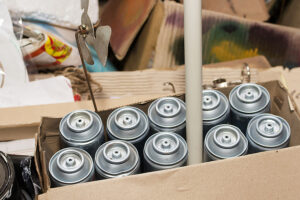France’s filling figures increased by 1.3% last year, despite varied segments

All segments combined increased from 649.78 million units in 2022 to 657.91 million units last year.
The CFA said last year's aerosol filling activity maintains the trend seen for last year; with France's aerosol industry maintaining a strong position in Europe - expected to be confirmed with the European Aerosol Association (FEA's) figures that are due this September.
Body care aerosol products grew by 11.1%, with the main increase evident with antiperspirant deodorant (+25%).
Shaving products rose by 22% and haircare products - excluding dry shampoo - by 13%.
In contrast, suncare, water sprays, dry shampoo and other body care products declined by 3.8%.
Homecare products grew by 8% and there was a strong increase for air fresheners (+34%), as well as products in the 'other' category (+66%).
The insecticides and horticultural products, however, underwent a significant drop (-54%).
Declining segment
The 'miscellaneous' category dropped by 35%, although the CFA said the segments making it up are not experiencing the same changes.
Pharmacy and veterinary segment also saw a decline (-4.5%) .
In contrast, the automotive/cycle, paint/industrial and technical products segment fell sharply (-43%), which is similar to the food/other segment, which is down by more than half (-51.2%).
In terms of insights for this year so far, the CFA said: "Our view is that supply chain disruptions will also have repercussions in 2024. Supply delays, raw material cost increase and the impact of inflation on purchasing power will also have an impact on the activity of the year. But as in 2023, not all segments will be impacted in the same way."
The full breakdown by category is as follows:
Personal care
An increase of +11.1% for a total filling of 497 million units of aerosol dispensers last year.
This segment accounts for 76% of the total aerosol units filled in France.
Deo and antiperspirants: +25%
Strong growth for this segment, which is major in terms of application. The launch of new brands and the long summer heat may explain this phenomenon, according to the CFA. Promotional activities may also have had an impact on demand. The segment accounts for 21% of French filling figures.
Haircare products (excluding dry shampoo): +13%
After declining in 2022, this segment returned to a higher level than 2022. It accounts for the largest share of total production in France, at 24%.
Shaving foams and gels: +22%.
This segment has returned to pre-COVID crisis levels. Its growth in 2023 represents 8% of production activity in France.
Suncare, watersprays, dry shampoos, others: -3.8%.
This segment had grown by 30% in 2022. In 2023, the decline of almost 4% takes it to a level which is still well above 2019 production.
Inflation's impact on purchasing power may explain the decline in this category of products, which are also highly versatile and quickly affected by external phenomena such as fashion or weather, said the CFA.
This segment still represents a significant percentage of 23% of the French production in 2023.
Household
Growth of 8% was recorded in this segment, with a total of 76 million aerosol dispensers filled last year, representing 12% of the total production.
Air fresheners: +34.5%
Strong growth last year is explained by consumers' need to purify their home, including places that are open to the public, according to the CFA. Promotional activity has undoubtedly also had an impact on demand, it added, explaining the growth in this segment, which accounts for 5% of total activity.
Insecticides and plants protection: -55%.
The drop of almost 15 million units shows that this sector suffered in 2023. The weather is still having a major impact (mosquitoes, hornets and other pests), but above all, biocide regulations in France are making it more complicated to place these types of products on the market. This segment represents 2% of total activity.
Textile/Carpet, furniture polish, oven cleaners, bathroom and kitchen cleaners, leather/shoe care and other household products: +66%.
By 2020, this segment had increased strongly due to demand for cleaning and disinfecting products. This new growth (the highest in 2023), representing +11 million units, reflects the need for effective products for a wide variety and specific aerosol applications, accounting for 4% of the total production.
Miscellaneous (automotive & cycles - paint & varnish - industrial and technical – pharma & vet - food and others)
In this segment, a total volume of 84 million units of aerosol dispensers was filled, down by -35% as compared to 2022. The segment has shrunk to 13% of the total activity.
Automotive & cycles/paint & varnish/industrial and technical: -43.5%
This segment, which represents 8% of total activity, was impacted by a shortage of raw materials, which prevented production from keeping pace with market demand.
However, the statistic commission questioned this drop, which could also be due to a wrong allocation of segment by some fillers.
The need for these specific products remains constant and the practicality and efficiency of aerosols as a form of packaging contribute to their attractiveness, said the CFA.
Pharma/vet: -4.5%
Last year, this segment stabilised at a lower level than 2019. Last year's decline of this segment, which still represents 4% of total business, seems to be explained by a reduction in ailments or illnesses, or by inflation, which has driven consumers towards other forms of product, said the CFA.
Food and various other: -51%
This segment, which had remained stable in 2022, saw a very significant drop in production last year. This is relative, given the low volume, but the percentage impact is substantial, added the CFA.
This segment represents less than 0.5% of the total production.









